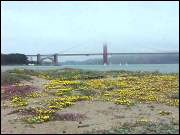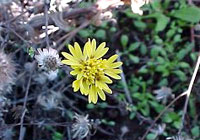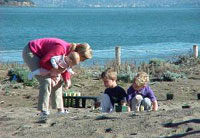This cold morning at the Presidio, elegant terns wheel over the lagoon at the edge of the San Francisco Bay, screeching like a fleet of squeaky bicycles. In the distance, fog blots out the top of the Golden Gate Bridge. On the strip of beach closest to the water, dogs chase tennis balls into the surf. And in restored sand dunes, volunteers yank non-native plants and pile them in trash bags. Around them, buckwheat blooms, its round purple globes adding color to the gray day.

The Presidio.
Photo: National Park Service.
Not long ago, this patch of shoreline was a parking lot split by a line of palm trees and contaminated with fuel. Now it is a teeming lagoon, and one of the more inspiring stories in the history of San Francisco habitat restoration. It is also one site in the heated, nationwide debate over non-native species — what they’re called, what they mean, and what we should do about them.
At the Presidio, the debate pits the Australian eucalyptus — dramatic trees with sickle-shaped leaves and a pungent smell — against the San Francisco lessingia, an unfortunately shrubby plant with tiny butter-colored flowers, whose beauty is best observed on your knees in the sand. The eucalyptus, which has been extraordinarily successful at taking root in California, is the nemesis of the state’s native-plants lovers; not only does it suck up needed water, it emits a toxin that poisons anything seeking to grow in its shade. The lessingia is an endangered species. One of its last strongholds is an area of the Presidio that is currently sliced into small chunks — sand dune, eucalyptus grove, sand dune, parking lot, eucalyptus grove. The U.S. Fish and Wildlife Service has drafted a recovery plan for the lessingia, and the plan calls for a continuous stretch of dunes. Translation: Some eucalyptus will have to go.

Learning a lessingia.
Photo: National Park Service.
To some people, getting rid of non-native plants to benefit native ones makes perfect sense. But San Francisco Chronicle columnist Ken Garcia is championing the cause of the eucalyptus. He bemoans the plan for “killing trees in the name of some sort of ecological purity” and takes issue with the way the trees are described. “Several of the program’s members have publicly stated that they view eucalyptus trees as weeds that should be eradicated,” he wrote. “Some of them began referring to any so-called non-native plants and trees as ‘alien’ species.” Taking the language issue more personally, City Supervisor Leland Yee (D) commented in another local paper, “How many of us are ‘invasive exotics’ who have taken root in the San Francisco soil, have thrived and flourished here, and now contribute to the wonderful mix that constitutes present-day San Francisco?”
Similar comments can be heard far beyond San Francisco. A woman who runs a garden project in New York City says community members adamantly oppose creating a patch of native plants. They want to grow flowers from all over the world, reflecting their neighborhood’s diversity. In Chicago, citizens rally behind the Argentinean monk parakeets that roost in city parks, adopting them as representatives of Chicago’s multiculturalism. The fondness for non-native plants and animals is particularly strong in urban areas, which are often insulated from the negative effects of invasive species and their $123 billion annual cost to the economy. In Montana’s Bitterroot Valley, where spotted knapweed makes prime pastureland inedible to livestock, or in the Great Lakes region, where the sea lamprey has swallowed a fishing industry, exotics are markedly less popular.

Eucalyptus invasion.
Word Games
While comments like those from Garcia and Yee distort the science (for starters, humans are all the same species, while eucalyptus and lessingia are not), they highlight an important failure of the restoration movement. The story often told to describe the effects of non-native species is that of immigrants taking over. Newspaper headlines like “Nature’s Immigrants” and “Unwanted Visitors” help create the perception that the desire to keep out foreign plants and animals is rooted in bigotry. The terms we are using to describe species — alien, exotic, and native — are also used for people. Even “invaders,” a term growing in popularity, summons fears of barbarians at the gate. These phrases get tossed around because they make good copy and tap into a visceral tale already simmering under the surface of the U.S. political landscape. But that is the wrong story, and the price of continuing to tell it is the alienation of the very communities the environmental movement needs most.
The language of that story is a legacy from an earlier time. In the late 19th century, as the U.S. government was preparing to pass the Lacey Act — one of the first federal tools for controlling non-native species — it was also wrestling with questions of human immigration. Scientists looking at the question of non-native species made overt comparisons to people, titling articles “The European Starling as an American Citizen.” Cheering the arrival of the English sparrow, the poet William Cullen Bryant wrote, “A winged settler has taken his place / With Teutons and men of the Celtic race. / He has followed their path to our hemisphere — / The Old World Sparrow at last is here.”

Volunteers help control invasives at the Presidio.
Photo: National Park Service.
There is a better story we could — and should — be telling. The language of foreigners and invaders seems to fit right into an anti-immigrant message, but the fact is that preserving native species fundamentally promotes diversity. An individual garden might contain more species if it germinates seeds from every continent, but worldwide, diversity loses every time a plant like the San Francisco lessingia is neglected. Both cultural and biological diversity are affected, because native plants are tied to local communities that use them for food, medicine, or ceremony. It may take time to find the words to recast the exotic species debate — to tell a tale that reflects the values of the 21st century rather than the 19th — but it will be worth the effort.
Back in the Presidio, on the north side of the lagoon where the soil is compact and marked by raccoon tracks, volunteers pull plantain. Each plant has a center of red-tinted leaves surrounded by a star of seed heads that curve out and up, flattening the plants around it and leaving an impression like a shoe. Native Americans, with their own terms for exotics, called plantain “Englishman’s footprint.” It’s no mystery why. The plant seemed to spring up wherever Europeans stepped. For now, plantain tramples all over these banks. But one by one, they’re disappearing. And each one yanked creates room for seeds of a plant community unique to this place, one that says “San Francisco” like no other could.


